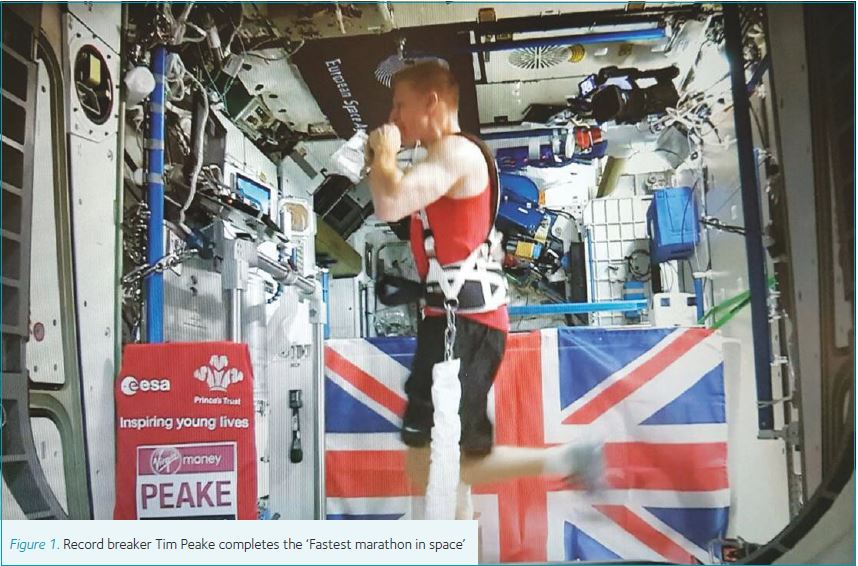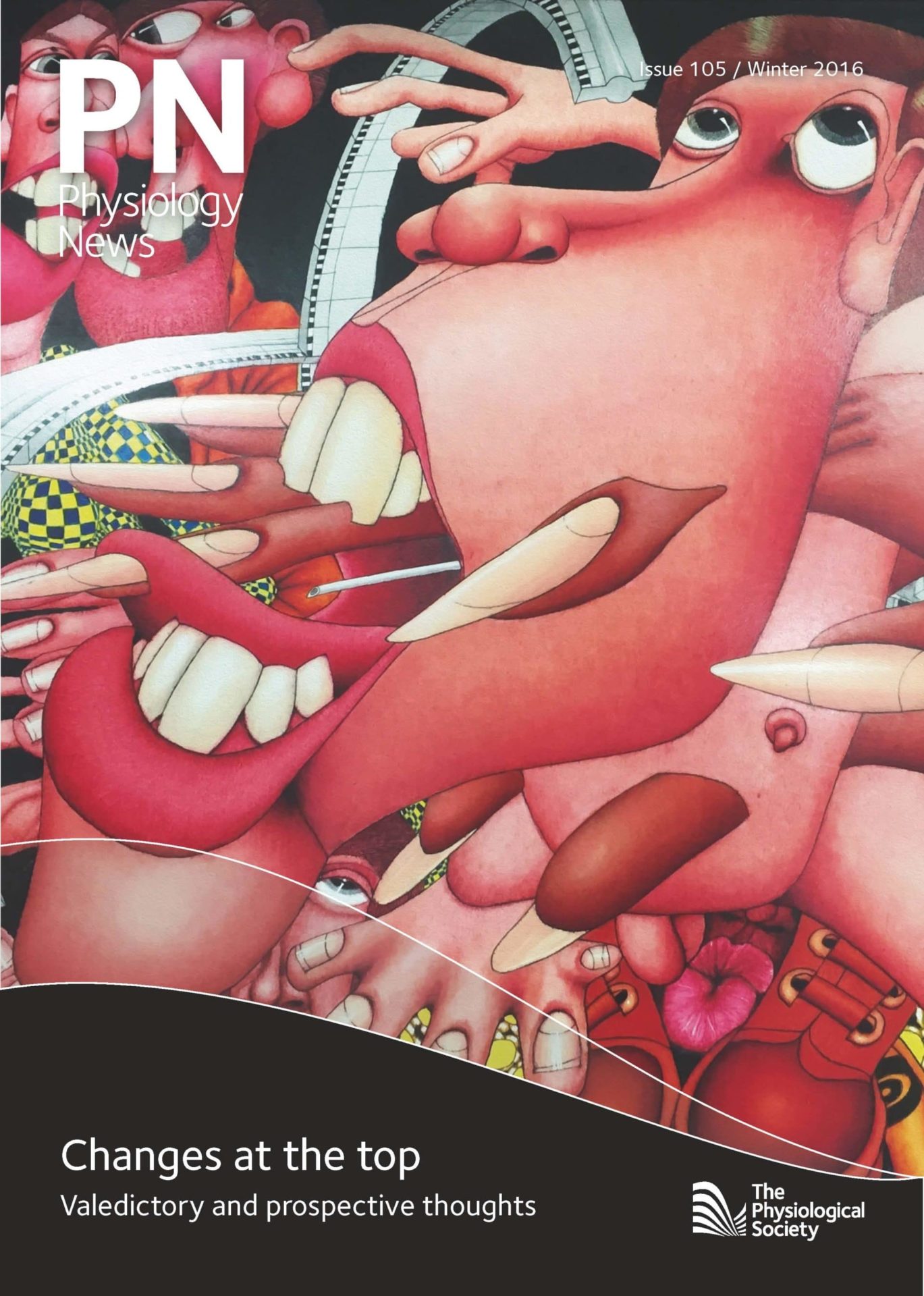
Physiology News Magazine
Exercise like an Astronaut
How crew members stay healthy aboard the International Space Station
Features
Exercise like an Astronaut
How crew members stay healthy aboard the International Space Station
Features
Alexander Ryan
University of Manchester, UK
https://doi.org/10.36866/pn.105.22
On the 24 April this year, a man received a Guinness World Record for completing the London Marathon in 3 hours, 35 minutes and 21 seconds. This time may not sound all that impressive, but the record ‘Fastest marathon in space’ was achieved by Major Timothy Peake while aboard the International Space Station (Lynch, 2016). He did this harnessed to a treadmill via bungee cords, allowing an insight into the specialised exercise equipment aboard the ISS.

Under periods of low exercise, skeletal muscle begins to atrophy. This leads to muscle wastage, and potentially sarcopenia over a long time. Atrophied muscle is physically smaller, and weaker than healthy muscle. Individual muscle fibres are decreased in both size and number, there are less type I fibre and more type II fibre (Narici & Maffulli, 2010). Type II fibres are more prone to atrophy, leading to further deterioration. As skeletal muscle is a major site for glucose dispersal, there is an association between sarcopenia and Type 2 Diabetes.
Due to the low gravity, or microgravity, on the ISS crew members do not routinely carry out exercise. Therefore skeletal muscle begins to waste away, bone mass decreases and the volume of the heart gets smaller. A major problem with space exploration is how to combat these. Currently the longest running experiment aboard the ISS is the effect of microgravity on the skeletal system.
Crew members can lose up to 25% of the muscle mass within 6 months aboard the ISS, with muscle power and force also being significantly decreased. Furthermore, the muscle fibre type is similar to that in sarcopenic muscle. ‘Spaceflight osteopenia’ can cause crew members to lose more than 1% of their bone mass every month. This causes bones to weaken, and can increase the frequency of fractures (Malik, 2009). Due to the decreased workload on the heart, the heart muscle begins to atrophy (Lewis, 2014). This leads to a smaller amount of blood being pumped, and this decreased amount of blood flow can lead to low blood pressure when crew members return to earth.
In order to combat this specialised exercise equipment had to be developed. There are three pieces of equipment currently present on the ISS; COLBERT, CEVIS (NASA, 2015) and ARED (NASA, 2015). COLBERT stands for Combined Operational Load Bearing External Resistance Treadmill, and is the treadmill Timothy Peake used for the marathon. In essence COLBERT works in a similar manner to a standard treadmill, although crew members are connected via bungee cords. CEVIS is even simpler, in that crew members are strapped to an ergometer similar to a stationary bike. The clever part of both COLBERT and CEVIS is the mechanism in which they are connected to the station. A vibration isolation system is in place to prevent crew members from affecting other parts of the ISS.
Whilst COLBERT and CEVIS are good for aerobic exercise, they do not effectively build muscle. This is why ARED was developed, to stimulate resistance exercise. ARED is the ‘Advanced Resistive Exercise Device’ and uses piston-driven vacuum cylinders to mimic several weight-lifting exercises. Key to the function of ARED is its flexibility. By manipulating the apparatus 29 different methods of weight lifting can be mimicked; from squats to dead lifts to bench presses. This allows all the major muscle groups to be worked out. Moreover, the load is adjustable meaning that all crew members can use the equipment.
Together with my team of volunteers, and a generous outreach grant from the Physiological Society, I visited the Bluedot Festival to explain how to ‘Exercise Like An Astronaut’. Under the gaze of the Lovell telescope at Jodrell bank our tent described the mechanisms of exercise aboard the ISS. Whilst talking visitors through the problems inherent with a stay on the ISS, we explained the counter measures taken. We then used air pumps to show how effective pistons could be, setting off bottle rockets and blowing up balloons.
An interesting caveat involved explaining the sheer amount of exercise undertaken on the ISS. Our volunteers were tired after only a few minutes of pumping, whereas crew members are encouraged to carry out two hours of exercise a day. The feedback received was overwhelmingly positive, and we had a lot of repeat visitors. Younger visitors enjoyed the practical part, whereas older visitors were interested in the actual science of muscle wastage. In an age where the amount of sedentary lifestyles is increasing, it was interesting to draw direct comparisons, and demonstrate how important exercise is.



References
Lewis T (2014). How Zero Gravity Affects Astronauts’ Hearts in Space. www.space.com/25452-zero-gravity-affects-astronauts-hearts.html
Lynch K (2016). ESA astronaut Tim Peake achieves Guinness World Records title for the Fastest marathon in space. guinnessworldrecords.com
Malik T (2009). Space Station Astronauts Lose Bone Strength Fast. www.space.com/6354-space-station-astronauts-lose-bone-strength-fast.html
Narici MV & Maffulli N (2010). Sarcopenia: characteristics, mechanisms and functional significance. Br Med Bull 95,139-159
NASA (2015). Advanced Resistive Exercise Device (ARED). www.nasa.gov/mission_pages/station/research/experiments/1001.html
NASA (2015). Cycle Ergometer with Vibration Isolation and Stabilization System (CEVIS).
www.nasa.gov/mission_pages/station/research/experiments/841.html
